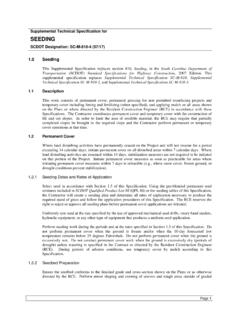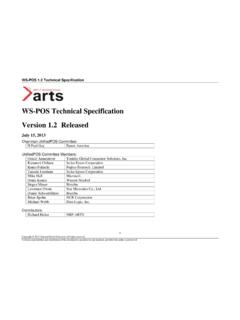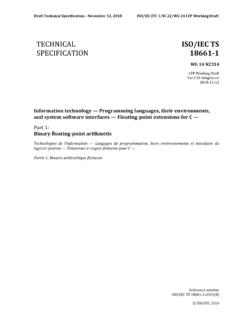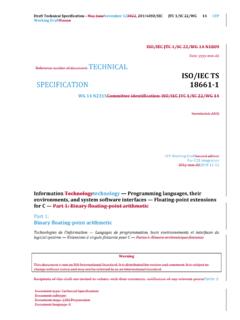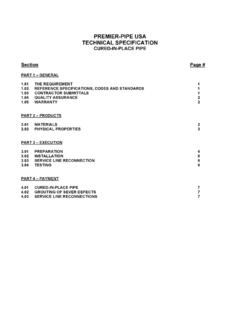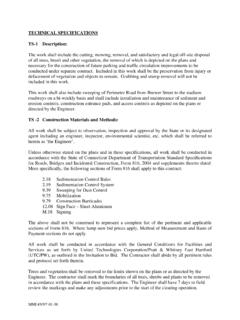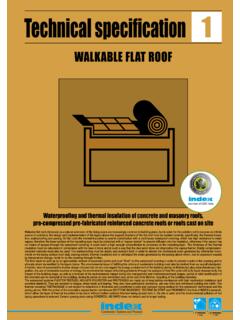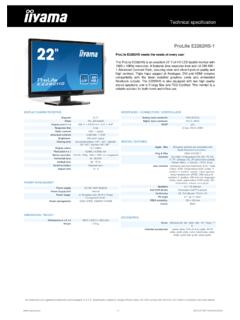Transcription of 400G-BD4.2 Multimode Fiber 8x50Gbps Technical Specifications
1 400G BiDi MSA Technical specification Rev Page 1 of 10 Multimode Fiber 8x50 Gbps Technical Specifications As Defined by the 400G BiDi MSA Revision September 1, 2018 Chair Mark Nowell, Cisco Co-Chair John Petrilla, FIT Editor - Randy Clark, FIT The following companies were members of the 400G BiDi MSA at the release of this specification : Company Alibaba Broadcom Cisco Corning Incorporated Foxconn Interconnect Technology InnoLight Technology Inphi Corporation Sumitomo Electric Releases: Revision Date Description 09/01/18 First publication 400G BiDi MSA Technical specification Rev Page 2 of 10 CONTENTS CONTENTS .. 2 TABLES .. 3 FIGURES .. 3 1 GENERAL .. 4 SCOPE .. 4 MODULE BLOCK DIAGRAM .. 4 FUNCTIONAL DESCRIPTION .. 4 MODULE HARDWARE SIGNALING PINS .. 5 MODULE MANAGEMENT AND LOW SPEED ELECTRICAL INTERFACE .. 5 HOST FEC REQUIREMENTS.
2 5 MODULE HIGH SPEED ELECTRICAL CHARACTERISTICS .. 5 MODULE MECHANICAL DIMENSIONS AND REQUIREMENTS .. 5 2 OPTICAL 5 OPTICAL 5 Transmit Optical 6 Receive Optical 7 Illustrative Link power 8 3 DEFINITION OF OPTICAL PARAMETERS AND MEASUREMENT METHODS .. 9 Optical Parameter and Measurement Methods .. 9 Optical Lane Assignments .. 9 MDI (Medium Dependent Interface) Requirements .. 9 4 MODULE COLOR 10 400G BiDi MSA Technical specification Rev Page 3 of 10 TABLES Table 2-1: Required Optical Link Distance Operating Range .. 6 Table 2-2: Transmit Characteristics .. 6 Table 2-3: Receive Characteristics .. 7 Table 2-4: Illustrative Power 8 Table 3-1: Electrical to Optical Lane Mapping for MPO Connector 8 Table 4-1: Module Color Coding .. 10 FIGURES Figure 1-1: Block Diagram for Transmit and Receive Paths .. 4 Figure 3-1: Optical Lane Assignments for.
3 9 400G BiDi MSA Technical specification Rev Page 4 of 10 1 GENERAL SCOPE This specification defines the 8x50 Gbps MMF optical interface for Ethernet applications. Using the specification , two transceivers communicate over Multimode optical fibers (MMF) of lengths from meters to 70 meters (OM3), 100m (OM4) and 150m (OM5). The transceiver electrical interface is not defined in this specification , but is typically deployed using eight lanes in each direction with a PAM4 encoded, nominal signaling rate of GBd ( Gbps) in each direction (400 GAUI-8 C2M per IEEE Std Annex 120E). Forward error correction (FEC) is required to be implemented by the host in order to ensure reliable system operation and is accommodated in the nominal signaling rate. A variety of form factors for transceivers are possible (such as QSFP-DD and OSFP) and none are precluded by this MSA.
4 MODULE BLOCK DIAGRAM NOTE specification of the CDR function is beyond the scope of this specification . NOTE: See Table 3-1 and Figure 3-1 for Electrical to Optical Lane Mapping for MPO Receptacle Figure 1-1: Block Diagram for Transmit and Receive Paths FUNCTIONAL DESCRIPTION modules comply with the requirements of this document and have the following common features: eight optical transmitters and eight optical receivers in a bi-directional optical configuration (four of the transmitters using a wavelength range of 844nm to 863nm, 1, and four of the transmitters using a wavelength range of 900nm to 918nm, 2), a signal detect for each optical receiver and a twelve channel MPO Fiber optic connector (only eight fibers total are required) using Multimode optical Fiber . 400G BiDi MSA Technical specification Rev Page 5 of 10 MODULE HARDWARE SIGNALING PINS Hardware signals and associated contact assignments are specified in the respective form factor Specifications (such as QSFP-DD or OSFP).
5 MODULE MANAGEMENT AND LOW SPEED ELECTRICAL INTERFACE The module management and low speed electrical interface is specified in the respective form factor Specifications (such as QSFP-DD or OSFP). HOST FEC REQUIREMENTS The host system is required to enable FEC for the module electrical interface in accordance with IEEE Std Clause and IEEE Std Annex 120E (400 GAUI-8). The option to disable the host FEC correction function is not addressed in this specification . Use of supplemental FEC capability within the optical module is not addressed in this specification . MODULE HIGH SPEED ELECTRICAL CHARACTERISTICS The detailed high speed electrical characteristics are not defined in this specification . The module electrical interface is intended to be in accordance with IEEE Std Annex 120E (400 GAUI-8). MODULE MECHANICAL DIMENSIONS AND REQUIREMENTS Module mechanical dimensions and requirements are specified in the respective form factor Specifications (such as QSFP-DD or OSFP).
6 2 OPTICAL Specifications OPTICAL Specifications The optical link distance operating range for the is defined in Table 2-1. A compliant PMD operates on Multimode fibers according to the Specifications in Table 2-4. A PMD that exceeds the required link distance operating range while meeting all optical Specifications is considered compliant. Table 2-1: Required Optical Link Distance Operating Range PMD Type OM3 Operating Range OM4 Operating Range OM5 Operating Range m to 70 m m to 100 m m to 150 m 400G BiDi MSA Technical specification Rev Page 6 of 10 For the PMD, the bit error ratio (BER) when processed by the PMA (IEEE Std Clause 120) shall be less than 10 4 provided that the error statistics are sufficiently random that this results in a frame loss ratio of less than 10 12 for 64-octet frames with minimum inter-packet gap when additionally processed by the PCS (IEEE Std Clause 119).
7 For a complete Physical Layer, the frame loss ratio may be degraded to 10 11 for 64-octet frames with minimum inter-packet gap due to additional errors from the electrical interfaces. If the error statistics are not sufficiently random to meet this requirement, then the BER shall be less than that required to give a frame loss ratio of less than 10 12 for 64-octet frames with minimum inter-packet gap. Transmit Optical Specifications Each lane of a transmitter shall meet the Specifications in Table 2-2. Table 2-2: Transmit Characteristics (TP2e) Parameter Value Unit Signaling Rate, each lane (range) 100 ppm GBd 1 Center Wavelength [Tx1, Tx3, Tx5, Tx7], each lane (range) 844 to 863 nm 2 Center Wavelength [Tx2, Tx4, Tx6, Tx8], each lane (range) 900 to 918 nm Modulation Format PAM4 RMS Spectral Width, each lane a (max) nm Average Launch Power, each lane (max) 4 dBm Average Launch Power, each lane (min) - dBm Outer Optical Modulation Amplitude (OMAouter), each lane (max) 3 dBm Outer Optical Modulation Amplitude (OMAouter), each lane b (min) - dBm OMAouter - TDECQ, each lane (min) - dBm Transmitter and Dispersion Eye Closure for PAM4 (TDECQ), each lane max dB TDECQ 10log10(Ceq), each lane (max) c dB Average Launch Power of OFF Transmitter, each lane (max) -30 dBm Extinction Ratio, each lane (min) 3 dB Transmitter Transition Time, each lane (max)
8 34 ps RIN12 OMA, each lane (max) -128 dB/Hz Optical Return Loss Tolerance, each lane (max) 12 dB Encircled Flux, each lane d 86% at 19um 30% at Test methodology is assumed to be based on IEEE Clause a RMS spectral width is the standard deviation of the spectrum. b Even if the TDECQ < dB, the OMAouter (min) must exceed this value. c Ceq is a coefficient defined in IEEE Std Clause which accounts for the reference equalizer noise enhancement. d If measured into type , or type , or type , 50 um Fiber in accordance with IEC 61280-1-4:2009. e TP2 as defined in IEEE Figure 138-2. 400G BiDi MSA Technical specification Rev Page 7 of 10 Receive Optical Specifications Each lane of a receiver shall meet the Specifications in Table 2-3. Table 2-3: Receive Characteristics (TP3g) Parameter Value Unit Signaling Rate, each lane (range) 100 ppm GBd 1 Center Wavelength [Rx1, Rx3, Rx5, Rx7], each lane (range) 844 to 863 nm 2 Center Wavelength [Rx2, Rx4, Rx6, Rx8], each lane (range) 900 to 918 nm Modulation Format PAM4 Damage Threshold, each lane a (min) 5 dBm Average Receive Power, each lane (max) 4 dBm Average Receive Power, each lane b (min) - dBm Receive Power (OMAouter), each lane (max) 3 dBm Receiver Reflectance, each lane (max) -12 dB Stressed Receiver Sensitivity (OMAouter), each lane c (max) dBm Receiver Sensitivity (OMAouter), each lane d (max) max ( , SECQ - 8) dBm Conditions of Stressed Receiver Sensitivity Test.
9 E Stressed Eye Closure (SECQ), lane under test dB SECQ 10log10(Ceq), lane under test (max) f dB OMAouter of each aggressor lane 3 dBm Test methodology is assumed to be based on IEEE Clause a The receiver shall be able to tolerate, without damage, continuous exposure to an optical input signal having this average power level on one lane. The receiver does not have to operate correctly at this input power. b Average receive power, each lane (min) is informative and not the principal indicator of signal strength. A received power below this value cannot be compliant; however, a value above this does not ensure compliance. c Measured with a conformance test signal at TP3 (see IEEE Clause ) for the BER specified in section d Receiver sensitivity is informative and is defined for a transmitter with a value of SECQ up to e These test conditions are for measuring stressed receiver sensitivity.
10 They are not characteristics of the receiver. f Ceq is a coefficient defined in IEEE Std Clause which accounts for the reference equalizer noise enhancement. g TP3 as defined in IEEE Figure 138-2. 400G BiDi MSA Technical specification Rev Page 8 of 10 Illustrative Power Budget An illustrative power budget and penalties for are shown in Table 2-4. Table 2-4: Illustrative Power Budget Parameter OM3 Value OM4 Value OM5 Value Unit Effective Modal Bandwidth at 850nm a 2000 4700 4700 MHz km Effective Modal Bandwidth at 918nm 1210 b 1850 b 2890 a MHz km Power Budget (for max TDECQ) dB Operating Distance 70 100 150 m Channel Insertion Loss c dB Allocation for Penalties d (for max TDECQ) dB Additional Insertion Loss Allowed 0 dB a Per IEC 60793-2-10. b Per draft IEC 60793-2-10 (subject to confirmation by TIA and IEC). c The channel insertion loss is calculated using the maximum distance specified and the cabled optical Fiber attenuation of dB/km at 850 nm, plus an allocation of dB for connection and splice loss (as given in IEEE Clause ).
